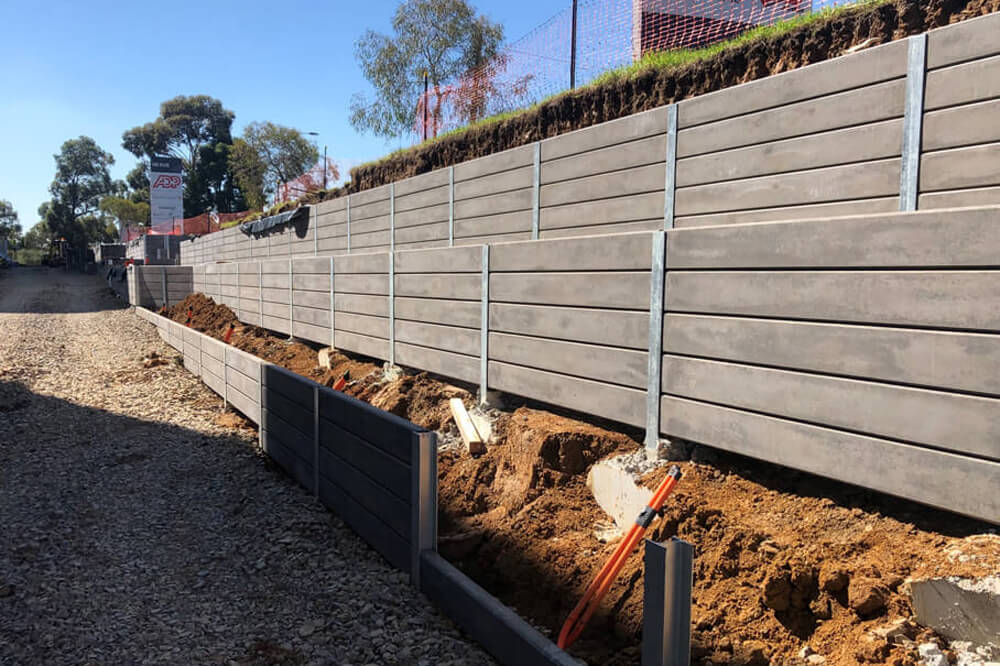Retaining walls play the vital role in managing soil preventing erosion or shaping our landscapes. Whether it’s a small garden wall or a large structural wall holding back tons of earth, their strength and durability depend on solid foundations. And that brings us to a crucial question: when should you use concrete footings in retaining wall repairs?
Let’s discuss this in depth, covering not just the “when,” but also the “why,” “how,” and “what happens if you skip it.” If you’re dealing with a failing or aging wall, understanding the purpose of concrete footings can save you from costly mistakes.
What Are Concrete Footings?
Before we dive into the specifics of repairs, let’s define what we mean by “concrete footings.”
Concrete footings are the thick, flat bases poured beneath retaining walls to distribute the weight of the structure evenly across the soil. They act like the shoes of a building, spreading pressure to prevent sinking, shifting, or cracking.
In the context of retaining walls, footings are particularly important because these walls endure immense pressure from the soil behind them, especially after heavy rains or shifting ground.
Are Footings Always Required?
No, not always. That might come as a surprise. While concrete footings offer unmatched stability, their necessity depends on several factors like wall height, soil type, load conditions, and climate.
So, when should you consider them? Let’s explore the signs and situations where concrete footings aren’t just helpful—they’re essential.
1. When the Original Wall Was Built Without a Proper Foundation
Have you noticed your retaining wall leaning, cracking, or bulging outwards? One common cause is the lack of a proper footing during the original construction. Many older or DIY-built walls rest directly on compacted soil or gravel, which might have worked short-term, but not in the long run.
When repairing such a wall, adding a concrete footing can prevent recurring failure. It’s a way to “do it right this time” by ensuring your wall has the stability it lacked before.
That’s why so many homeowners trust RainierRockeries.com for reliable retaining wall repair in Seattle, WA. Their team understands how to reinforce failing structures with expertly designed footings that last.
2. When the Retaining Wall Is Over 3-4 Feet High
Any wall above 3-4 feet in height typically requires engineering oversight—and, yes, a concrete footing.
Let’s discuss why height matters.
As a wall grows taller, lateral earth pressure increases exponentially, not linearly. This means a five-foot wall doesn’t just have a little more pressure than a three-foot wall—it may have double.
So, if your repair involves a tall retaining wall, concrete footings should be part of your plan.
3. When Soil Conditions Are Unstable or Poor-Draining
Not all soils are created equal. Some are stable and compact; others shift, swell, and become unstable after a rain.
Sandy soils may wash out easily, especially if not properly compacted. In such cases, a concrete footing provides a solid, unmoving platform, anchoring your wall despite the soil’s behavior.
Do you know your soil type? If not, it might be worth having it tested before diving into repairs.
4. If You’re Rebuilding After Structural Failure
Repairing a retaining wall isn’t just about patching cracks or replacing a few blocks. Sometimes, the failure is so severe that partial fixes won’t cut it. If a wall has already toppled, buckled, or shifted significantly, it’s time to rebuild with a better foundation—literally.
This is where concrete footings shine.
By starting with a reinforced base, you can rebuild the wall stronger than before. Many contractors pour new footings with steel reinforcement bars (rebar) to add extra stability, especially for walls under heavy loads.
5. In Freeze-Thaw Climates
If you live in a region that experiences freezing temperatures, you’ll want to take frost heave into account. This natural cycle—where moisture in the soil freezes, expands, and then thaws—can slowly push a wall upward or shift it sideways.
Concrete footings can be placed below the frost line to prevent this. That means the footing is poured deeper than the soil layer affected by freeze-thaw, so the wall stays put year-round.
So if you’re repairing a wall in, say, Minnesota or upstate New York, deeper concrete footings are likely non-negotiable.
6. When the Wall Supports Additional Loads
Is your retaining wall supporting more than just soil?
Some walls hold back driveways, parking areas, or even buildings. Others may have fences or decks mounted on top. These “live” and “dead” loads add more force on the wall—forces that only a reinforced footing can handle effectively.
In these scenarios, repairs must account for the added weight. A new concrete footing designed with rebar reinforcement is often the safest route.
What Happens If You Skip the Footing?
That’s a question worth asking. Some property owners attempt to save money or time by skipping the footing and simply resetting or replacing the wall blocks.
While this might offer a short-term solution, you’re essentially building on shaky ground—literally. Over time, that repaired wall could begin to lean again, develop new cracks, or collapse entirely. You’ll be back at square one—except this time with even higher repair costs.
Let’s discuss another risk: water damage. Without a proper footing, water can pool beneath the wall, weaken the soil, and accelerate erosion, compounding the pressure on the wall face.
Bottom line: skipping footings is like patching a tire with chewing gum. It won’t last long, and it might cause a bigger problem later.
How Are Concrete Footings Installed During Repairs?
You might be wondering: how does one even add footings to an existing or partially damaged retaining wall?
The process typically looks like this:
- Demolition – The damaged section of the wall is removed.
- Excavation – A trench is dug where the new footing will go, often below the frost line or as per engineering specs.
- Formwork and Rebar – Wooden or metal forms are built to shape the concrete, and steel rebar is laid inside to reinforce the footing.
- Pouring Concrete – The concrete is poured and leveled, then left to cure for several days.
- Rebuilding the Wall – Once the footing is fully cured, the new retaining wall can be built on top, layer by layer, with proper drainage systems included.
It’s labor-intensive, yes. But it’s also the most reliable way to ensure the wall holds up for decades.
Should You DIY or Hire a Pro?
Let’s be honest—not everyone has the tools, skills, or time to pour concrete footings and rebuild a retaining wall. The precision needed for excavation, leveling, and drainage makes this a task better left to professionals in most cases.
If your wall is under 2 feet and not load-bearing, a handy homeowner might manage a simple repair. But if we’re talking about larger walls, unstable soils, or previous failures, it’s wise to consult a structural engineer or licensed contractor.
Besides, a professional will know the building codes and obtain the right permits, saving you headaches down the road.
Conclusion: Know When to Build Stronger
Concrete footings aren’t always necessary for retaining wall repairs, but they are a smart investment in many situations, especially when safety, soil pressure, and wall height come into play.
Let’s review the key takeaways:
- Use concrete footings when the wall is tall, failing, or supporting extra loads.
- Footings are essential in unstable soils and frost-prone areas.
- A proper footing can turn a temporary fix into a long-lasting solution.
Still unsure whether your wall needs a footing? Ask yourself: Would I rather rebuild now, or repair it again in two years?
By understanding when to use concrete footings in retaining wall repairs, you not only protect your property but also increase its value and safety.
So, are you ready to strengthen your wall from the ground up?





























